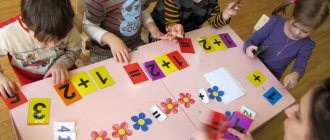Didactic game “Yesterday, today, tomorrow”
Goal: to develop children’s ability to navigate time, to consolidate the concepts of “yesterday”, “today”, “tomorrow”.
Material: multi-colored stripes, a selection of poems.
Progress of the game: the teacher explains that every day, in addition to its name, has another name (yesterday, today, tomorrow).
The day that has come is called today.
A day that has already ended is yesterday.
And the day that is yet to come is tomorrow.
We designate the colors (stripes): today – blue, yesterday – blue, tomorrow – purple.
First, we fix the color designation: the teacher names the concepts, the children show the corresponding strip.
Then the teacher reads the poem, the children determine what day the poem is about (yesterday, today, tomorrow) and show the corresponding strip.
Ball game "Yesterday, today, tomorrow"
Goal: to develop children’s ability to navigate time, to consolidate the concepts of “yesterday”, “today”, “tomorrow”.
Material: ball
Progress of the game: the teacher throws the ball to the children one by one, saying a short phrase, for example, “We are doing...” The child who caught the ball finishes the phrase (... today).
Example phrases:
We are going to walk…
Did you go to the park...
We will read a book...
Didactic game “Colorful week”
Goal: to consolidate ideas about the days of the week, to consolidate the names and sequence of the days of the week, to develop navigation skills in the days of the week.
Material: multi-colored circles, numbers from 1 to 7.
Progress of the game: the teacher on the demonstration circle indicates the color and names the day of the week, the children show the corresponding number.
Option 1: the teacher shows the numbers from 1 to 7 in order, the children show the corresponding color on their circles and name the day of the week.
Didactic game “Week, line up”
Goal: to consolidate ideas about the days of the week, to consolidate the names and sequence of the days of the week, to develop navigation skills in the days of the week.
Material: numbers 1-7.
How to play: There are upside-down cards with numbers on the table. Children take cards from the table at a signal. They look for their partners, that is, they line up in order and name their day of the week (“The first is Monday, the second is Tuesday...).
Tasks:
1. The teacher asks to leave the day that represents Monday;... Wednesday, etc.
2. The teacher asks for the day of the week that comes after Monday, before Saturday, between Tuesday and Thursday, etc.
3. The teacher asks to come out the days of the week that are after Thursday (children with the numbers five, six, seven come out); before Wednesday (children with numbers one, two) and name their days of the week.
Ball game “Catch, throw, name the days of the week”
Goal: to consolidate ideas about the days of the week, to consolidate the names and sequence of the days of the week, to develop navigation skills in the days of the week.
Material: ball.
Progress of the game: children form a circle. The teacher stands in the middle of the circle. He throws a ball to one of the children and says: “What day of the week is today?” The child who caught the ball answers: “Tuesday.” Then the teacher throws the ball to another child and asks a question like: “What day of the week was yesterday?”
Question options:
Name the day of the week after Thursday. Name the day of the week between Thursday and Friday, etc.
If someone finds it difficult to quickly give an answer, the teacher invites the children to help him.
Ball game “It happens - it doesn’t happen”
Goal: to develop verbal and logical thinking, to consolidate ideas about the signs of the seasons.
Material: ball.
Progress of the game: the players stand in a circle. The teacher names a sign of a certain time of year. The child catches the ball if this sign is appropriate.
Exercise “Repeat, don’t make a mistake”
Goal: to consolidate the names of the months (according to the seasons).
Progress of the game: the child names the names of the autumn (winter, spring...) months in order, with or without pictures.
Ball game "Carry on"
Goal : develop time orientation skills, consolidate the ability to name the signs of the seasons.
Material: ball
Progress of the game: children and the teacher stand in a circle, the teacher names the season and gives the ball to the child, the children name the signs of this season and pass the ball around the circle.
Summary of an open lesson on the topic Days of the week in the preparatory group
Outline of the open lesson “Days of the week”.
Preparatory group Teacher: Kuznetsova S.N. Group: 1 preparatory, correctional. Type of activity: application Methods and techniques : game, conversation, joint creativity. Materials and equipment: interactive whiteboard, magnetic board, applique kit (cardboard, colored paper - strips of 7 colors, scissors, glue, napkin). Goal: developing children's knowledge about the days of the week, their order and cyclicity. Objectives: Educational
To form knowledge about the days of the week and consolidate it.
Developmental
We develop thinking, interest in the topic, and the ability to apply knowledge in practice.
Educational
We cultivate the ability to play and work together, to help each other.
We cultivate perseverance and discipline during classes. Preliminary work: Reading fairy tales with the number 7. “Snow White and the Seven Dwarfs”, “The Tale of the Dead Princess and the Seven Knights”, “The Wolf and the Seven Little Goats”, “The Seven Brave Ones”. Hot ball game. Children stand in a circle and pass the ball to each other. If you agree that you cannot pick up the ball on a certain day of the week, then whoever catches it is eliminated from the game. The chosen day of the week is constantly changing. Lesson plan 1. Organizational moment. 2. Warm up. 3. Lesson. 4. Consolidation of acquired knowledge and skills 5. Cleaning the workplace. ORGANIZING TIME. 1. I inform you about the topic of the lesson. 2. I suggest a warm-up. Yes-no attention game. Children repeat the movements of the teacher and nod their heads to answer the question YES or NO. — Did you eat a bun on Monday? (Boat style) Yes! - Tuesday. Are you out for a walk (marching)? Yes! — Did a star fall on Wednesday? (Squat down)? No! — Did you have a dream on Thursday? (hands cupped under cheek) Yes! And an elephant flew across the sky? (We wave our hands) No! — On Friday, did we wash our hands (three palms)? Yes! Did you wipe them on your pants? (We wipe our palms on our knees) No! — Did the cat eat jam on Saturday and Sunday? (“Lick” palms) No! The days of the week are unnoticeable, as if birds have flown by! Did you like the game? Yesss! )) We then played this game every morning and on our walks. PROGRESS OF THE LESSON Once again we inform the students about the topic of the lesson “Days of the week”. We ask the question - how many days are there in a week? Together we call the days again and count them. Seven days. I’m telling you that storytellers love the number seven. I propose to remember the fairy tales that we previously read. “Snow White and the Seven Dwarfs”, “The Wolf and the Seven Little Goats”, “The Tale of the Dead Princess and the Seven Knights”, “The Seven Braves”. We also remember from music classes that there are also seven notes. And there are seven colors in the rainbow. I’m talking about how the days of the week not only follow each other and hold hands tightly, but also constantly repeat themselves, as if they are standing in a round dance. During the walk, we added some variety to the game “hot ball”. Let’s say the day of the week is “Wednesday”, you can’t pick up the ball. Whoever was inattentive and picked up the ball is out. The days of the week are constantly changing. I am demonstrating a large cardboard clock, where the days of the week are brightly displayed in the colors of the rainbow. And the arrow goes around in a circle. Therefore, after Sunday there is always Monday. A day of the week cannot disappear or get lost, cannot change its order and stand in a circle twice in a row. Every day has its place. To reinforce interest and easy memorization, I demonstrate a small animation on the board in two different versions. The heroes are little blue people - the Smurfs. The evil Gargamel kidnapped Smurfette and in order to save her, you need to climb a ladder of 7 steps. In the first option, one step (medium) is missing and the Smurf falls. I clarify with the children what needs to be done to help the Smurf? Return the step-medium to its place! I demonstrate the second animation, where all the steps are in place and OP! The Smurf is on target, Smurfette is saved! We conclude that every day of the week the dodzhen will be in place and none of them can disappear. I invite the children to build a ladder themselves using the appliqué method. PROGRESS OF WORK Finger gymnastics. We look at the finished work on a magnetic board. We check that we have everything we might need at our workplace. This is a sheet of cardboard, strips of colored paper in rainbow colors, glue, a glue brush, scissors, a board for work, a napkin. Let's talk about the rules for working with scissors. We discuss the stages of work: Cut a strip of a certain color. We get seven stripes. We lay out the prepared material according to the sample on a magnetic board. Let's check. We work with glue. Treat with a napkin. We decorate the work with pre-prepared flowers made with a figured hole punch. In any order, as you want and like. We collect unused working material, scissors and glue. Based on the finished application, we repeat the names of the days of the week. The attendants are collecting work material. Thanks for the work! Let's relax!
We recommend watching:
Abstract of the GCD on the topic: Winter for children of the preparatory group. Summary of a lesson on speech development for children of the preparatory group. Early spring Summary of GCD in the preparatory group on the topic: Circus. Speech development Joint activity for children of the preparatory group. Travel through fairy tales
Similar articles:
Summary of the lesson “Take care of nature” in the preparatory group
Formation of concepts in children 4-5 years old - week, days of the week
Experience in “Formation of concepts in middle preschool children - week, days of the week”
My material will be of interest to teachers of middle preschool groups, students and interested parents Goal : To form in children temporary concepts of “week”, “days of the week”; why the week and its days received such names; fix the sequence of days of the week and the serial number of the day; learn to correlate the day of the week and the symbol - color, number. A child’s readiness for school , in addition to intellectual readiness, includes important components: good physical health, the ability to communicate with children and adults, high cognitive activity, the ability to perceive the world around him and adapt to new social conditions, independence, and the ability to plan one’s activities. , spatiotemporal orientation. It is vital for preschoolers to learn how to navigate time themselves: to determine, measure time, correctly denoting it in speech, to feel its duration in order to regulate and plan activities, changing their actions depending on the availability of time. We introduce children to the world around them, in which all events and changes in phenomena occur in time. The temporal characteristics of the unfolding of real phenomena, their duration, the order in which they follow each other, the speed of occurrence, the frequency of repetitions and rhythm must be shown and explained to preschool children. Time is perceived by the child directly, through the concretization of temporary units and relationships in constantly recurring phenomena of life and activity. Children's ideas about such periods of time and their discrimination skills, which are formed on the basis of personal experience, are more accurate. Therefore, children need to be introduced to such time intervals that can be used to measure and determine the duration, sequence, and rhythm of their actions and various types of activities. From the age of 4 you can start learning about the days of the week. It will not be easy for a child to remember the days of the week, but teachers must approach this issue creatively. At the very beginning of my work, I tested children in order to find out what children knew about the days of the week and asked the following questions: “What days of the week do you know? What day of the week is it today? The children's answers showed that the names of the days of the week are learned by children with difficulty and unevenly. Children know days of the week such as Sunday, Saturday, Friday, Monday better than Tuesday, Wednesday and Thursday. Consequently, the names of the days of the week are acquired by the child in connection with his life experience, the nature of his activities, and the emotional experiences that have arisen. Many children knew the days of the week - Monday and Friday. Other days of the week were often confused, replacing the name of one day of the week with another, or calling the month instead of the day of the week, or saying “today”, “tomorrow”, or even simply (cloudy day, sunny day). I also found out whether the children knew the sequential connection of the days of the week by asking questions: “What day of the week is today? What day of the week was yesterday? What day of the week will be tomorrow?" - it turned out that the children knew the previous, past day better than the present one. To identify an understanding of the sequence of alternating days of the week and the relationship between them in direct and reverse order, children were asked questions like: “What day is before Monday and after Monday?” Some of the children named which day would be before and after the one named, they restored in their memory a chain of words-names of the days of the week and accurately identified the previous and subsequent days. The remaining children experienced various difficulties in establishing relationships in direct and reverse order of the days of the week. Often children named the entire chain of names in a low voice and, having reached the indicated day, called the next day loudly. At the same time, it was much more difficult for them to name the previous day. The test results showed that asking the question about the day of the week itself causes difficulty for children. Having some specific ideas, the children found it difficult to correlate them with the desired concept. Children's knowledge about time periods is inaccurate and not systematized. I concluded that I, as a teacher, need to structure my work in such a way as to help students consolidate their knowledge on this topic. I organize my work as follows. First, I form ideas about weekends, then about the first and last days of the week, then about Tuesday, Wednesday and Thursday. Only after this we build a model of the week with the guys. In the process of forming ideas about the days of the week, I draw on the personal experience of children’s lives and activities, paying attention to what days there are musical, theatrical activities, physical education, etc. I use various visual materials: - A seven-flowered flower whose petals “come off” with each subsequent day of the week; - a circle divided into 7 multi-colored parts with an arrow in the middle; (children’s ideas about the days of the week can be associated with ordinal numbers, and each day of the week can be designated by a number, attached to parts of the circle every day from Monday to Friday. On Friday you can add Saturday (“What day of the week will it be tomorrow?”), and (“What day week will be the day after tomorrow?) (“What day of the week was yesterday?”) Every morning we remember with the children: “Today is the first day of the week - Monday. Let’s attach the number 1.” “What day of the week is it today? What is Monday?”; children can ask questions: “Why is this day called Tuesday?”, “What day comes after Tuesday?” “Which day is Wednesday in order?” “What is the name of the fourth day of the week?”, “How many days are there in the week?”, etc. d. To repeat and consolidate ideas about the days of the week, I use a variety of didactic games, such as: “Catching the days of the week”, “Catch, throw, name the days of the week” (with a ball), “What should be why?”, “What should be why? ”, “Listen and remember”, “Weekend-weekdays”, “Be attentive!”; Literary works: learning children's poems on the theme of E. Stekvashov “Week”, A Usachev “Seven days of the week”, Yu Moritz “Where did Monday go, physical minutes. Increased the level of pedagogical culture of parents; pedagogical education of parents; strengthened cooperation with the family, consultations for parents were collected. “Why you need to learn the days of the week”, “We teach the days of the week easily and with pleasure”, “We teach the days of the week.” I introduced parents to didactic and role-playing games, outdoor games that contribute to the development of children’s time concepts - the week, the days of the week. Work experience shows that children have knowledge about the “week”, “days of the week”; children learned why the week and its days received such names; The sequence of days of the week and the serial number of the day were fixed, children learned to correlate the day of the week and the symbol - color, number. I am sure that in the future, it will be much easier for my kids to acquire knowledge about time concepts - month, seasons, etc. The visual material I use when working on this topic. - A seven-flowered flower whose petals “come off” with each subsequent day of the week. Each color corresponds to a specific day: Red - Monday, orange - Tuesday, yellow - Wednesday, green - Thursday, blue - Friday, blue - Saturday, purple - Sunday.
— A circle divided into 7 multi-colored parts with an arrow in the middle; (children’s ideas about the days of the week can be associated with ordinal numbers, and each day of the week can be designated by a number.
-Pictures with an “image” of each day of the week and poems for them.
We recommend watching:
Familiarization of preschoolers 5-7 years old with nature in kindergarten Experience of working as a kindergarten teacher. Educational innovations Kinesiology in kindergarten Experience as a preschool teacher. Paper crafts to prepare preschoolers for writing
Similar articles:
From work experience. Nurturing a culture of verbal communication in preschoolers








